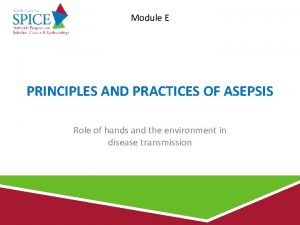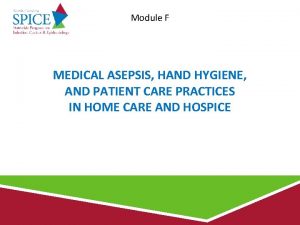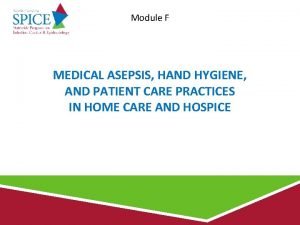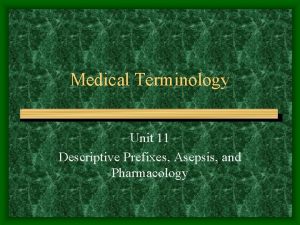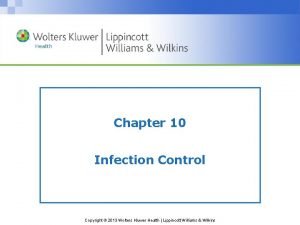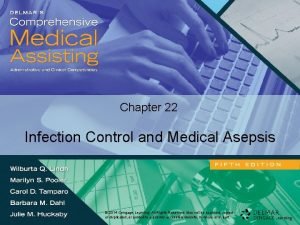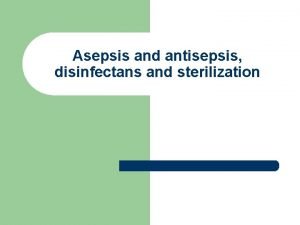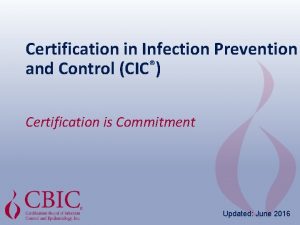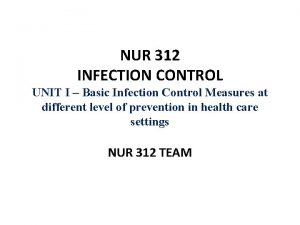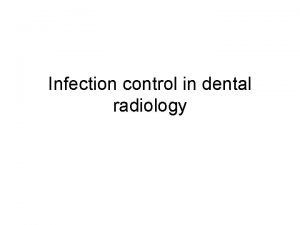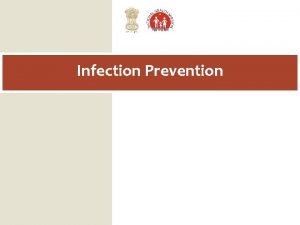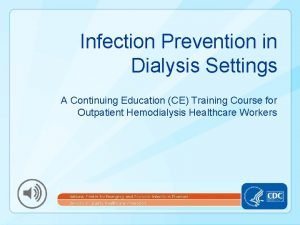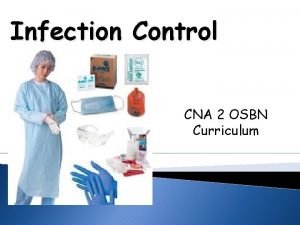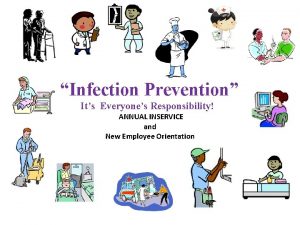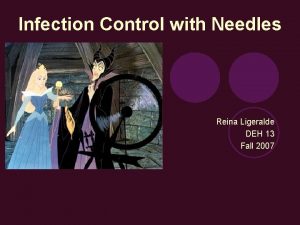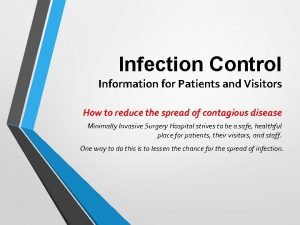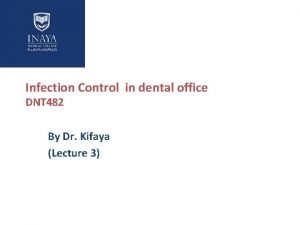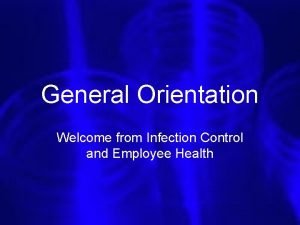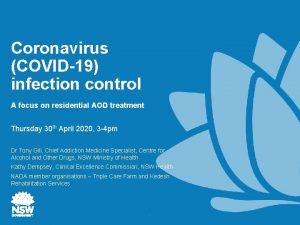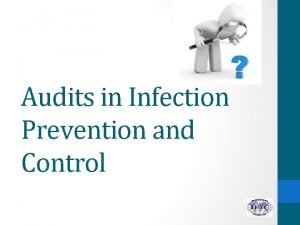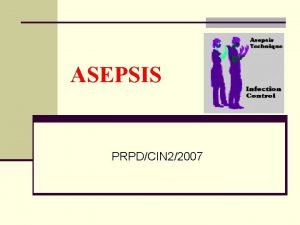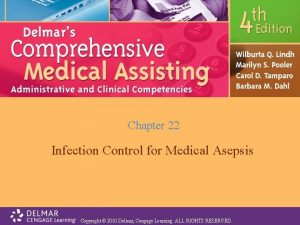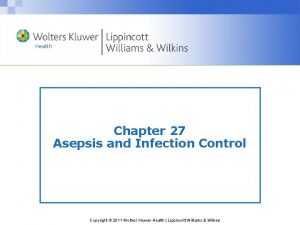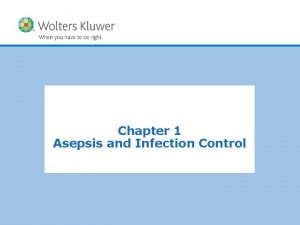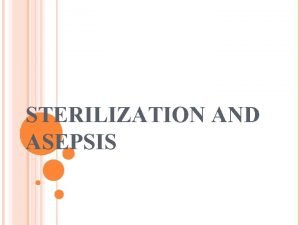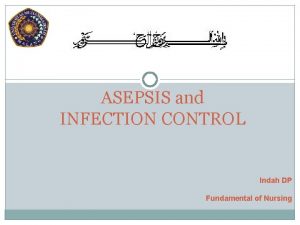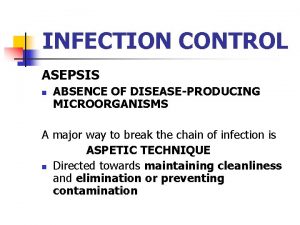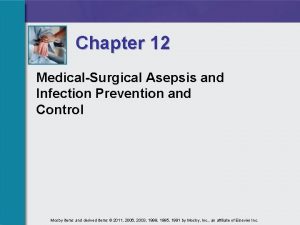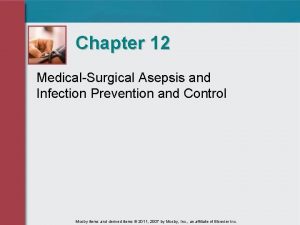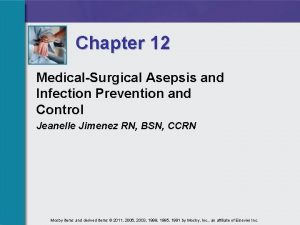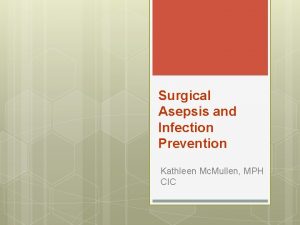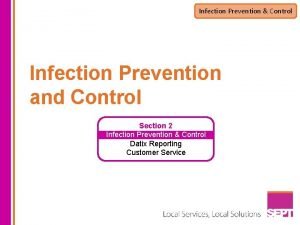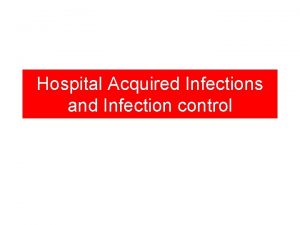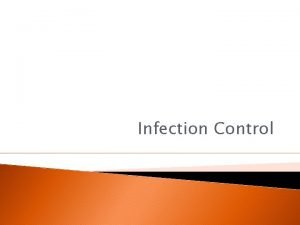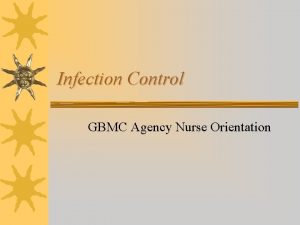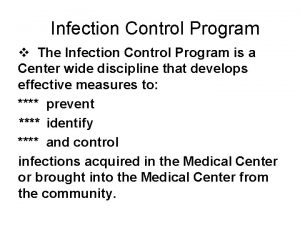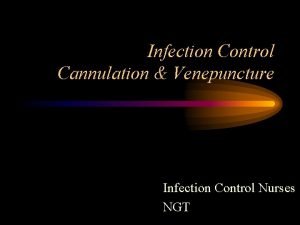Chapter 36 Infection Control and Medical Asepsis Copyright



























- Slides: 27

Chapter 36 Infection Control and Medical Asepsis Copyright © 2012 Delmar, Cengage Learning. All rights reserved.

Infection Control • Infection control is an ongoing aspect of working in health care • What is asepsis? – The state of being free from pathogenic microorganisms Copyright © 2012 Delmar, Cengage Learning. All rights reserved.

Microorganisms • Some microorganisms are helpful and necessary – Normal flora: A balance of microorganisms that provide a natural immunity against certain infections • Some microorganisms cause disease; these are called pathogens Copyright © 2012 Delmar, Cengage Learning. All rights reserved.

Microorganisms • Requirements to sustain life and facilitate growth and development: – Oxygen – p. H – Temperature – Nutrients – Water – A host to inhabit Copyright © 2012 Delmar, Cengage Learning. All rights reserved.

Preventing Disease Transmission • Communicable Diseases – Review Table 36 -1 – Learn these common diseases, their means of transmission, incubation times, symptoms, and treatments Copyright © 2012 Delmar, Cengage Learning. All rights reserved.

The Infection Cycle Copyright © 2012 Delmar, Cengage Learning. All rights reserved.

Infectious Agents • • • Bacteria Viruses Fungi Parasites Ricksettiae Copyright © 2012 Delmar, Cengage Learning. All rights reserved.

Reservoir or Source • Person who, or object that, becomes infected – Examples: People, equipment, food, water, insects • Allows the infectious agent to survive, grow, and multiply Copyright © 2012 Delmar, Cengage Learning. All rights reserved.

Portal of Exit • Exit from the reservoir (source) that allows the infectious agent to be transmitted • Secretions, excretions, body fluids Copyright © 2012 Delmar, Cengage Learning. All rights reserved.

Means of Transmission • How the infectious agent travels through the portal of exit into a susceptible individual • Can occur through direct or indirect contact – Direct: touching, eating, drinking – Indirect: inhalation, vector, fomite Copyright © 2012 Delmar, Cengage Learning. All rights reserved.

Susceptible Host • One that is capable of being infected – Disease-fighting capabilities are lowered – May be due to poor health or hygiene • Individuals who are elderly, frail, immunosuppressed, or have a chronic disease are particularly susceptible Copyright © 2012 Delmar, Cengage Learning. All rights reserved.

Infectious Disease Process • • • Incubation Prodromal Acute Declining Convalescent Copyright © 2012 Delmar, Cengage Learning. All rights reserved.

Immunity • Immunity is best when your body is in a state of good physical, emotional, and mental health Copyright © 2012 Delmar, Cengage Learning. All rights reserved.

The Body’s Defense Mechanisms • • Nutrition and exercise Proper rest Good hygiene habits Respiratory tract – Cilia – Coughing and sneezing – Tears, sweat, urine – Hydrochloric acid in stomach Copyright © 2012 Delmar, Cengage Learning. All rights reserved.

Infection Control in the Medical Office • • Patient education Proper cleaning Practice Universal and Standard Precautions Follow OSHA guidelines – The blood-borne pathogen standard – Complete an incident report after potential exposures Copyright © 2012 Delmar, Cengage Learning. All rights reserved.

Hand Washing • The most effective way to eliminate many diseases! Copyright © 2012 Delmar, Cengage Learning. All rights reserved.

Hand Washing • Appropriate times to perform hand washing – Before and after seeing patients – Before and after using the restroom – Before and after handling specimens or soiled/contaminated materials – After removing gloves • Hand washing versus surgical scrub • Using an alcohol-based rub Copyright © 2012 Delmar, Cengage Learning. All rights reserved.

Gloving • Necessary when exposed to blood or bodily fluids • Provides a barrier protection – Reduces the transfer of pathogens • Not a substitute for hand washing Copyright © 2012 Delmar, Cengage Learning. All rights reserved.

Applying Other PPE • Selecting the right personal protective equipment (PPE) for potential exposure is key Direct hand contact exposure Gloves Potential splashes, sprays, or droplets Gowns or labcoats, safety glasses, face shields Airborne transmission Face shields or masks Copyright © 2012 Delmar, Cengage Learning. All rights reserved.

Sanitization • Apply gloves before sanitizing objects • Washing and scrubbing to remove materials – Rinse in cool water – Soak in detergent – Wash with brush – Rinse thoroughly – Dry Copyright © 2012 Delmar, Cengage Learning. All rights reserved.

Disinfection • Items are placed in chemical solutions to kill disease-producing microorganisms • Used on objects only Copyright © 2012 Delmar, Cengage Learning. All rights reserved.

Sterilization • Process that destroys all forms of living organisms – Sterilization by autoclave – Chemical sterilization – Dry heat sterilization Copyright © 2012 Delmar, Cengage Learning. All rights reserved.

Autoclaving • Sanitize articles • Wrap articles to be autoclaved – Several items may be wrapped together, with gauze square between – Take caution not to wrap too loosely or tightly – May use envelope packaging – Use indicator tape or device to ensure quality control Copyright © 2012 Delmar, Cengage Learning. All rights reserved.

Wrap Items for Autoclaving Copyright © 2012 Delmar, Cengage Learning. All rights reserved.

Autoclaving • Follow manufacturer’s directions for operating the autoclave Copyright © 2012 Delmar, Cengage Learning. All rights reserved.

Chemical Sterilization • Used for – sharp items and instruments that would otherwise dull; – rubber or vinyl items that cannot withstand autoclaving heat • Cover item completely with solution; soak for a minimum 10 hours or manufacturer’s guidelines Copyright © 2012 Delmar, Cengage Learning. All rights reserved.

Dry Heat Sterilization • Used for sterilizing sharp instruments • Time consuming, takes 1 -2 hours at a high temperature Copyright © 2012 Delmar, Cengage Learning. All rights reserved.
 Difference between medical and surgical asepsis
Difference between medical and surgical asepsis What is medical asepsis
What is medical asepsis Medical asepsis definition
Medical asepsis definition Seps/o medical term
Seps/o medical term Chapter 16 infection prevention and control
Chapter 16 infection prevention and control Chapter 16 infection control and standard precautions
Chapter 16 infection control and standard precautions Chapter 15:9 maintaining transmission based precautions
Chapter 15:9 maintaining transmission based precautions Chapter 15:5 sterilizing with an autoclave
Chapter 15:5 sterilizing with an autoclave Chapter 10 infection control
Chapter 10 infection control Chapter 22 surgical asepsis
Chapter 22 surgical asepsis What are standard precautions milady
What are standard precautions milady Cbic recertification
Cbic recertification Antisepsis vs asepsis
Antisepsis vs asepsis Dental radiography techniques ppt
Dental radiography techniques ppt Cic certification
Cic certification Infection control meaning
Infection control meaning Darkroom infection control guidelines
Darkroom infection control guidelines Learning objectives for infection control
Learning objectives for infection control Conclusion of infection
Conclusion of infection Osbn cna
Osbn cna Infection control is everyone's responsibility
Infection control is everyone's responsibility Infection control
Infection control Nsw health
Nsw health Infection control information
Infection control information Root locus drawer
Root locus drawer Infection control orientation
Infection control orientation Infection control
Infection control Infection control audits
Infection control audits
